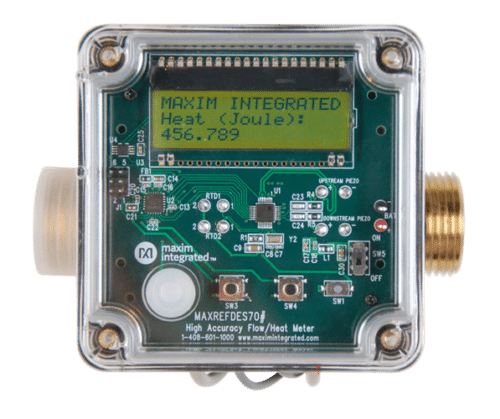The power of ultrasonic flow measurement is within reach. Harness time-of-flight technology to create low-power solutions for liquid and gas flow systems.

Ultrasonic flow meters are transforming the measurement of liquid and gas flows. These meters are essential for revenue collection, leak detection, and the conservation of natural resources, making them central to utility and industrial systems for water, gas, and heat distribution. Mechanical flow meters, which use moving parts to measure fluid velocity, are the most common type. The MAXREFDES70 ultrasonic time-of-flight (TOF) flow meter by Maxim Integrated uses piezoelectric transducers to send and receive ultrasound waves both upstream and downstream within a pipe. The flow rate can be determined by measuring the difference in the TOF between the two directions and applying digital signal processing techniques.
Using this reference design, design engineers can develop ultrasonic flow meters that measure liquid and gas flow for applications such as utility systems for water, gas, and heat distribution. This design allows engineers to move beyond mechanical flow meters, using piezoelectric transducers to measure TOF differences between waves travelling upstream and downstream in a pipe to calculate the flow rate.
At the system’s core is the MAX35101, which integrates functions for automatic TOF measurements, including ultrasound pulse generation, detection, TOF calculation, temperature measurement, and a real-time clock (RTC). The time-to-digital converter operates in various automatic event timing modes, requiring minimal interaction from the host microcontroller, reducing overall power consumption.
The system operates on the TOF measurement principle. It features two piezoelectric transducers that function as transmitters and receivers for ultrasound waves. The meter alternately transmits and receives ultrasound pulses between the transducers, with pulses travelling downstream and upstream. Ultrasound pulses travel faster downstream than upstream, and the TOF difference between these two directions is proportional to flow velocity. A larger TOF difference indicates faster fluid flow. When fluid flow stops, the TOF difference becomes zero. The MAX35101’s digital processing, analogue front-end circuits, and calculation algorithms ensure that TOF measurements are reliable.
The device simplifies flow computation with automatic differential TOF measurement. Early edge detection ensures consistent wave patterns and reduces errors. A built-in arithmetic logic unit calculates TOF differences, while a programmable receiver hit accumulator minimises the need for host microprocessor intervention.
The system is controlled by the EFM32ZG110, a 32-bit ARM Cortex-M0+ microcontroller running at 14 MHz with 32 KB of internal flash. The microcontroller communicates with the time-to-digital converter and an LCD module via SPI and GPIO pins. The MAX4721 is a low-voltage, low-on-resistance analogue switch used to isolate the LCD module’s SPI interface when the LCD is powered off, reducing current leakage to 5 nA and conserving battery life.
Maxim Integrated has tested this reference design. It comes with a bill of materials (BOM), schematics, assembly drawing, printed circuit board (PCB) layout, and more. The company’s website has additional data about the reference design. To read more about this reference design, click here.






